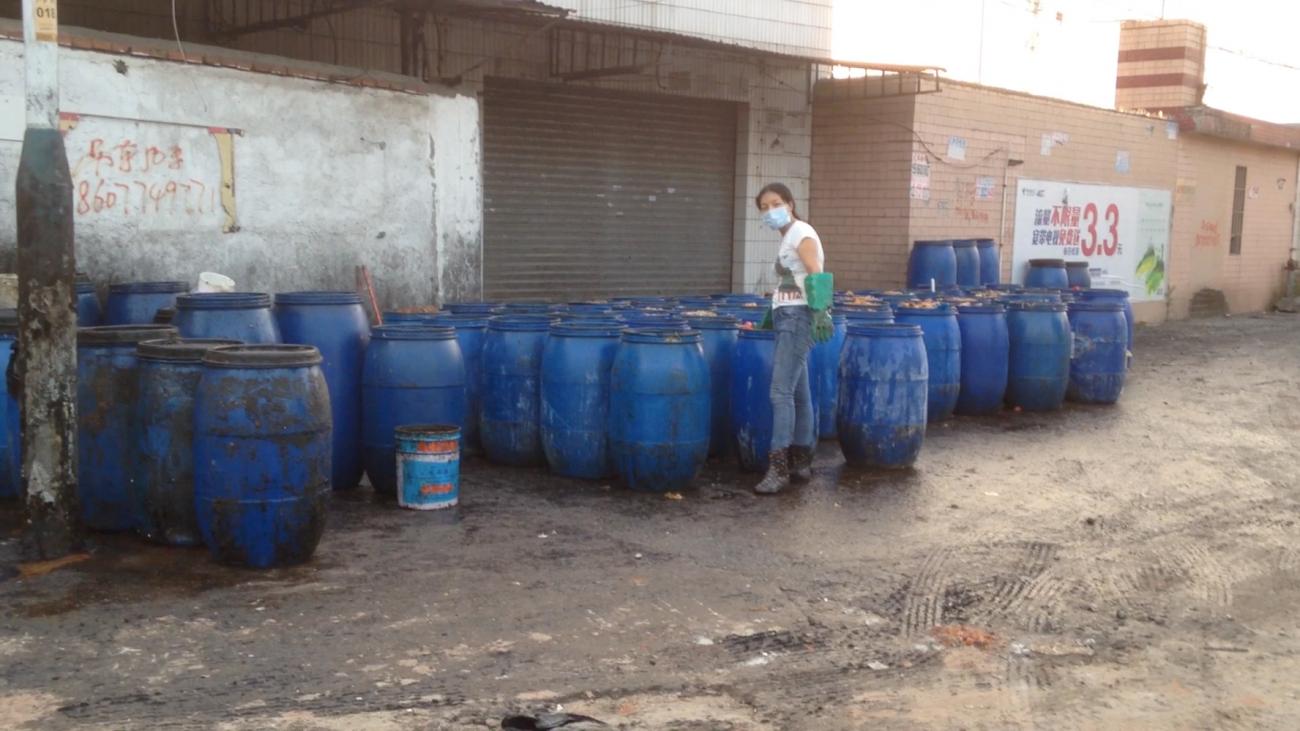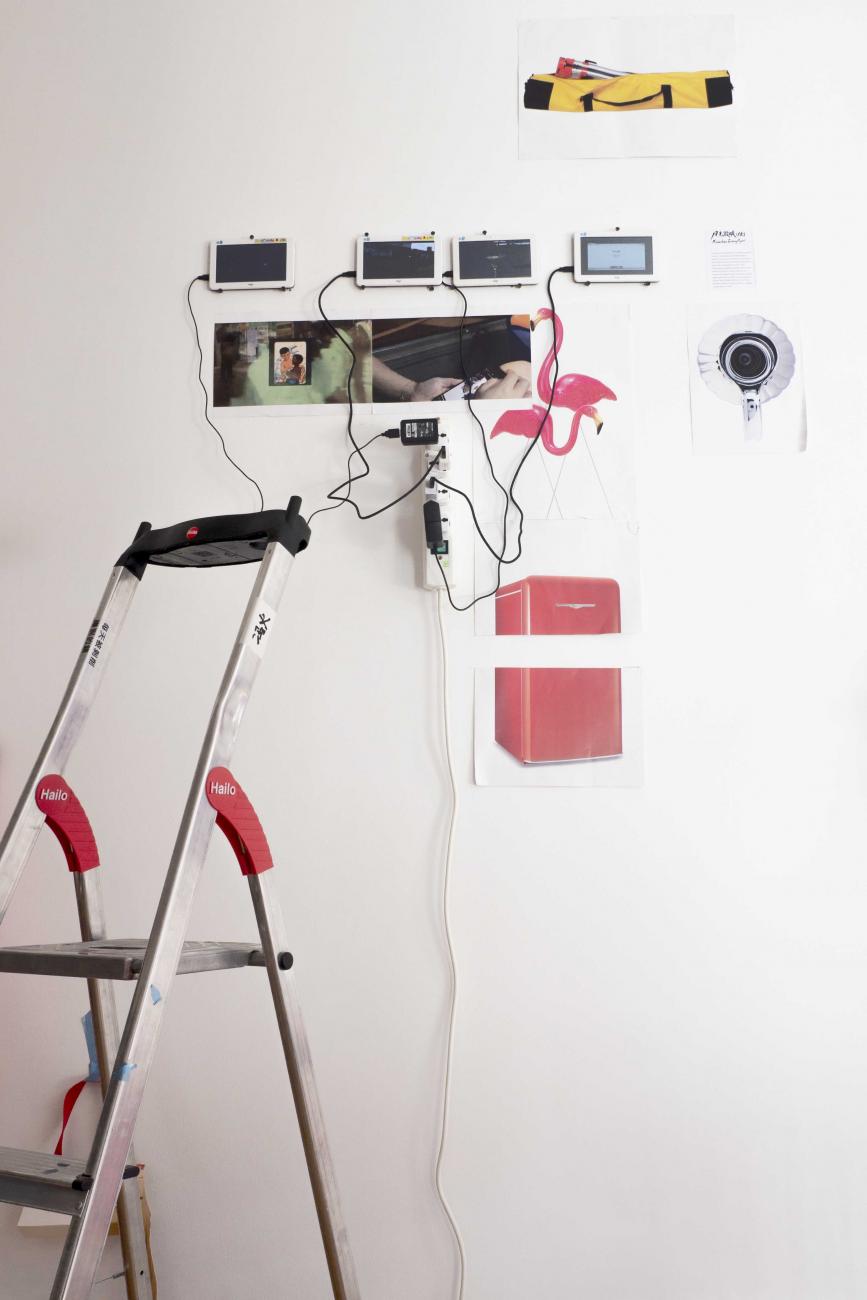13.8.2019 20:00Soeng Joeng Toi

Ou Feihong: Burning (2019), 10’07’’, film still

Moonshine Screening Project, installation view at SYNNIKA, 2019
What are the common features of Square, Park, Fairyland and Ruins?
That they are all man-made, artificially defined, managed or abandoned?
That they are all distinguished with memorability?
That they are within reach but out of control?
Or that they have been trendy once one after another and asleep in dust in other times?
Square:
Open urban spaces where citizens gather and separate,
representation of the wilds that, driven by animal instincts as well as calling by urban residents;
Surreal spiritual terrains subtly constructed by their rebellious objects, and in which the participators would subconsciously become anti-capitalistic and anti-disciplinary;
A sudden and sophisticated integration of the most splendid and ruined parts of human civilisation….
Going across thousands of squares on this planet, and they are just points of departure for memories and forgotten histories….
Park:
In Chinese, a ‘park’ literally means a public garden. That maybe because, in the past, ‘garden’ only refer to the ones that are privately owned or possessed by the aristocrats.
In the period of socialism, the most common name of a park was the ‘People’s Park’, an idealised community of collectivism.
Would a lazy, non-striving flaneur/ wanderer/tramp in the park equate himself with ‘people’?
Could loneliness and self-consolation achieve the occupation of parks, when ‘love and peace’ become the slogan of squatting/ occupation?
Fairyland:
If happiness can be produced elaborately, can sorrow be commodified?
How is 36 months of life being told about the specific image of happiness?
Ball pools could still stimulate my natural interest at the age of 30….
Does escaping from the homogenized secular happiness mean being graceful and transcendent?
Ruins:
The ruins are always relative to human activities.
In the human world, all ruins have the value of being transformed from waste into treasures.
The ruins is a new type of composite geological resources. For instance, the longer age the minerals endured, the more valuable they are, becoming the paradise of capital.
On the other hand, those temporary ruins that sprout in the suburbs( the crack of capital integration) are usually ignored by human beings and become a paradise for non-human life/inanimate objects.
They are beneficial and healthy, popular and loved by the mass.
But they can also be shoddy, fake and despondent.
They can cultivate commonality, but can also be the faked version, which can not produce “undistorted communication” (Jürgen Habermas)
The following short films, entered these public spaces in Canton, China.
(Text: Moonshine Screening Project— Zimu,Yubin, Alu)
1 Fairyland yet to dream, 07’04 (2019)
This short video is inspired by the Guangzhou Children’s Park that was demolished in 2001 due to the excavation of the ruins of Nanyue Kingdom Palace. Wei used it as a narrative framework, linking it to the discussion on how homogenized methods of production compose contemporary happiness.
Xin Wei (born 1992 in Guangzhou) currently lives and works in Guangzhou and Shanghai. He graduated from the School of the Art Institute of Chicago. He creates research-based narrations using mixed media, including writing, programing, sculpture, and moving image.
His recent research is primarily concerning with the production logistics behind everyday objects that carry messages of social class and exist within the society of the spectacle. He purchases small projects from online retailers and commissions factories around China to witness their work process. With these actions, he attempts to create a re-narration of the production-consumption-production circle.
2 Burning, 10’07’’ (2019)
Introduction: A young beautiful mother is taking care of her children while sorting out pigwash in the suburb of Guangzhou. She said, there was no other way for us.
The overall environment has tightened and deviated to the right since the end of 2017. Looking around and seeing all evil, incapable as I am, can only go to the ruins to paint and set them on fire.
Cast: He Quan, Xie Shaoya, Liang Manyong
Ou Feihong:
Freelancer, currently work and live in Guangzhou, China. (ins:oufeihong)
3 Those Squares, 21’08’’ (2019)
Will you still experience nostalgia when the world starts to forget everything? Will you believe in the power of daydreaming? Will there be an explanation to everything that exists or has disappeared? Will you still remember those everyday feelings? This video documents the changes and memories that take place by the roads- just a small corner of a big city.
Lu Xinyang
She is an illustrator but now makes videos for documentation. She is a video game lover, an ordinary and friendly person, daydreaming in her conservative daily life.
4 Occupy Qing Xi Park, 07’42’’ (2017)
I returned to the small town Qing Xi where I grew up and documented how migrant workers were utilizing the public space, particularly the town park in their leisure time. They performed a certain type of occupation of the park (time, space, mind…). Together with participatory filming from the workers and my own reminiscence, the video serves as an affective archive of the world factory coming to an end.
Zimu Zhang:
Zimu Zhang is a moving image practitioner and researcher. She is currently conducting her PhD research at City University of Hong Kong. Her research focuses on the conjunction of moving image with new materiality and society of control. She is also active in film curating, alternative space building and socially engaged art practices. She is the co-founder of the Moonshine Screening Project, one of the proprietors of the co-organized space Soeng Joeng Toi in Guangzhou.
广场、公园、乐园与废墟
广场、公园、乐园与废墟,这些空间有什么相同之处么?
都是人为建造、定义与管制/放弃?
都是记忆性显著的空间?
都触手可及而又无从把握?
都在某个时刻相继时髦过,而其余时间沉睡在浮尘里?
广场:人在城镇中聚集与离散的宽广空间,动物本能所需的旷野重现;潜意识反抗资本与权力规训的超现实精神场域,由其反抗对象而悉心建设…人类文明最辉煌与破败的瞬间整合,走过地球上千万座GC,只是纪念与遗忘的起点…
公园:公园的中文字面涵义是公共的园林,或许因为园林,在古代,总是私家的,贵族的,而进入社会主义时期,公园最普遍的名字是人民公园,一个集体主义的理想化的共同体。一个懒散的,不上进的,在公园游荡的人,会把自己与人民划等号么?当爱与和平可以成为占领的口号,孤独和自我安慰可以实现对公园的占领么?
乐园:如果说快乐是被精心生产而成,那悲伤能否被商品化?36个月的生命如何被告知快乐的具体形象?波波池在我30岁的时候仍然能激发起那天然的趣味…逃离被同质化生产的“世俗的快乐”,便可清新脱俗?
废墟:废墟总是相对于人类活动的,在人类世,一切废墟都有可变废为宝的价值,废墟是一种新型复合地质资源,像矿物,年代越久远越值钱,越是资本舞蹈的乐园。而那些在城郊萌芽的暂时性废墟(资本整合的间隙),被人类所忽视,成为非人类生命/无生命物的乐园,
它们是有益身心健康的,大众喜闻乐见的,
但它们也可以是劣质的,仿造的,丧气的
它们可以孕育公共性,但也可能是假冒的公共领域(哈贝马斯),无法产生“未失真的沟通(undistorted communication)”
以下几个短片,进入了这几种公共空间,在广东,在中国。
(文字:月光放映计划—— Zimu, Yubin, Alu)
1《浮园遗梦》,07’04 (2019)
这个短片是关于2001年因南越王宫遗址的挖掘而被拆除的广州市儿童乐园。艺术家以此作为框架,去链接当下的世俗间的快乐是以何种同质化的生产方式去达到的。
辛未: 1992年生在广州,本科毕业于芝加哥艺术学院,现生活和工作在上海广州两地;他的媒介囊括写作,编程,雕塑,影像等多种混合形式,以完成他相关研究的复合叙事。辛未近期的研究主题主要关注景观社会之中具备阶级特征的日常物品生产逻辑。他最近经常就通过网络购买各类小商品和对全国各地工厂下各类订单以推进工作进度,并在其中展开生产-消费-生产这一轮回的再叙述。
2《燃烧》,10’07’’ (2019)
一个年轻美貌的妈妈在郊野之地一边带养小孩一边分类猪食,她说,我们都是没有了办法。2017年底大环境极速收紧转右,转项顾盼,恶象环环,人生无能,唯剩入废墟画画放火。
出演:何泉、谢少亚、梁曼勇
欧飞鸿:自由职业, 目前工作生活于中国广州 (ins:oufeihong)
3 《广场的角落》, 21’08’’ (2019)
在这个时代,好像一切都必须要是新的,旧的东西很快就会被抛弃,什么痕迹也不会留下。一切也好像必须是快乐的,不快乐的东西会被轻易遗忘,否则痛苦不会有尽头。习以为常到不值得怀念的东西,有一天会突然随着看不到的规则或者纠纷人间蒸发。“我曾纪录的这个大城市某处角落的景象,甚至在我纪录它的时候,它就不应该在那里。”
卢心洋: 她是一个有一定纪录片工作经历的插画师,现在开始尝试独立制作纪录短片。她喜欢电子游戏,是个普通而友善的人, 总是在局促的日常生活中做白日梦。
4 《占领清溪公园》,07’42’’ (2017)
我回到我所成长的东莞小镇清溪,通过个人纪录及参与式拍摄,考察外来务工人员如何在节假日期间对所在的打工城镇公共场所,即位于清溪镇中心的清溪公园进行利用以及某种程度上的占领(时间,空间,心理等)。串联起来的影像素材和我对自身成长的回忆一起成为这一世界工厂尾声时期的情态档案。
张子木:动态影像实践者和研究者,目前在香港城市大学进行博士研究,专注于动态影像和新物质性、控制社会的结合地带。她也活跃于电影策划,替代性空间建设和社会参与性艺术。她参与运行的“月光放映计划”,是广州共治空间“上阳台”的业主之一。